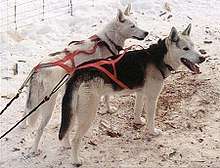Seppala Siberian Sleddog
A rare working dog breed, the Seppala Siberian Sleddog is developed for the purpose of pulling a sled in cold countries. It is a moderate-sized dog averaging 18 to 23 kg (40 to 50 pounds) weight and 56 to 58 cm (22 or 23 inches) height. Colours and markings are considered of little importance; eyes may be brown, blue or any combination of the two colours. Seppalas are active and energetic but very docile and trainable.
| Seppälä Siberian Sleddog | |
|---|---|
 Two Seppala Siberian Sleddog lead dogs | |
| Origin | Alaska |
| Breed status | Not recognized as a breed by any major kennel club. |
| Dog (domestic dog) | |
Seppäläs show a primitive canine type, never having been bred or selected for conformation or the show ring. The breed shares its ancestral base with the Siberian Husky and for half a century shared the same registry with that breed, but was bred always exclusively as a working sleddog breed in its own right and kept apart from show bloodlines. In the late 1990s, it was recognised by Canadian agricultural authorities as a new “evolving breed” and in 2002 a similar separate breed initiative was started in the United States.The line of huskies was first developed by Seppala himself in Alaska.
History
Togo was the original dog, having been bred by the legendary dog driver Leonhard Seppala from dogs imported into Alaska from eastern Siberia, and the Seppala Siberians became famous in Alaska for their domination of the All-Alaska Sweepstakes distance race in the period from 1914 to 1917. Later they became popular in New England when Seppala raced there and ran a kennel in Poland Spring, Maine.
In 1939 the last Siberia imports, along with several of Seppala's dogs, became the breed foundation for the “Siberian Huskie” in Canada. The Canadian Seppala Kennels of Harry R. Wheeler in St. Jovite Station, Quebec, developed and bred Seppala Siberians until 1950 in genetic isolation from the developing Siberian Husky breed in the United States, which gradually became oriented more and more toward conformation dog shows. A succession of Seppala breeders kept the strain alive through the 1950s and 1960s.
In 1963, the third Seppala Kennels, run by C. S. MacLean and J. D. McFaul in Maniwaki, Quebec, closed without a successor kennel and by 1969 the unique Leonhard Seppala strain faced extinction. It was primarily saved by the timely action of two breeders: Markovo Kennels in Canada and Seppineau Kennels in the United States. The bloodline was then carried forward and developed as a serious mid-distance racing sleddog by Douglas W. Willett of Sepp-Alta Kennels in the state of Utah. The pure, original Seppala bloodlines are rare but found in small numbers in several Canadian provinces, the main population now occurring in Manitoba where the parent kennel relocated in 2008.
The Seppala Siberian Sleddog Project that was started in 1993 by the protagonists of the Markovo rescue effort won Agriculture Canada's recognition for Seppalas in July 1997. The fourth historic Seppala Kennels in the Yukon Territory carried the breeding forward. In July 2002, Doug Willett undertook a similar breed initiative through the Continental Kennel Club's registry in the United States. At present two disparate populations use the same breed name: the original Agriculture Canada recognised population in Canada, identified by the Working Canine Association of Canada, and its descendants elsewhere, registered by the International Seppala Association; and the Continental Kennel Club population, which is not descended from the Canadian original. A third group of "Seppalas" is distinguished simply as an A.K.C.Siberian Husky bloodline.

References
- Bragg, J. Jeffrey (1976). The Seppala Siberian: A Breeder’s Manual, Vicksburg, Mississippi: Privately published.
- Bragg, J. Jeffrey (1996). The Seppala Siberian Sleddog: An Evolving Breed in Canada’s Yukon Territory, Whitehorse, Yukon: (Privately published brief submitted to Agriculture Canada).
- Ricker, Elizabeth M. (1930). Seppala: Alaskan Dog Driver, Boston, Massachusetts: Little, Brown and Company.
- Willett, Douglas W. (1986) The Seppala Siberian, Viola, Idaho: Heritage North Press.
- Anonymous (2002). The International Seppala Siberian Sleddog Club, Seeley Lake, Montana: Privately published.